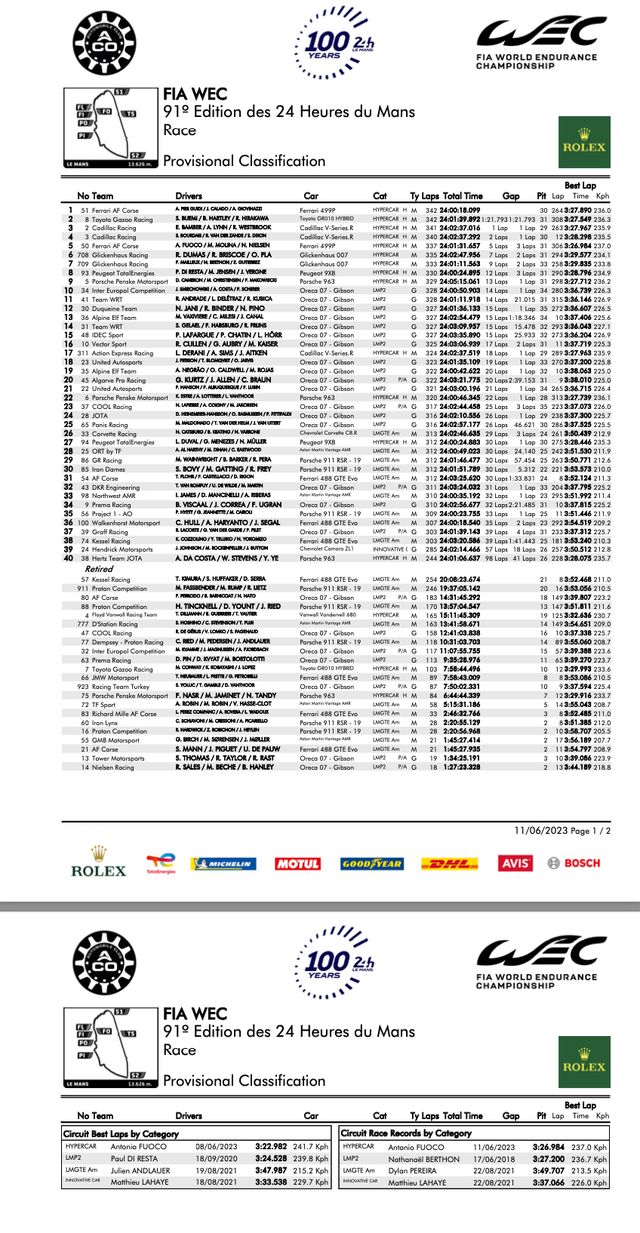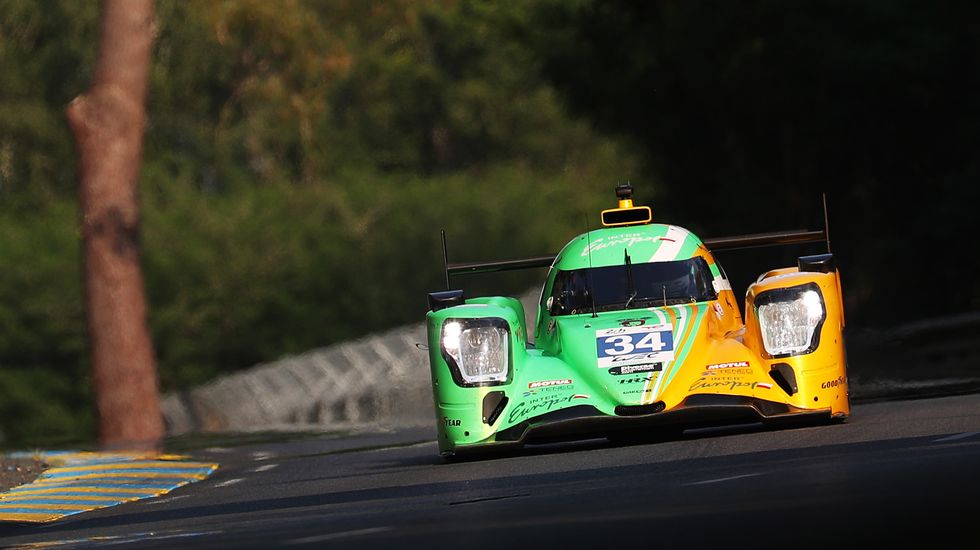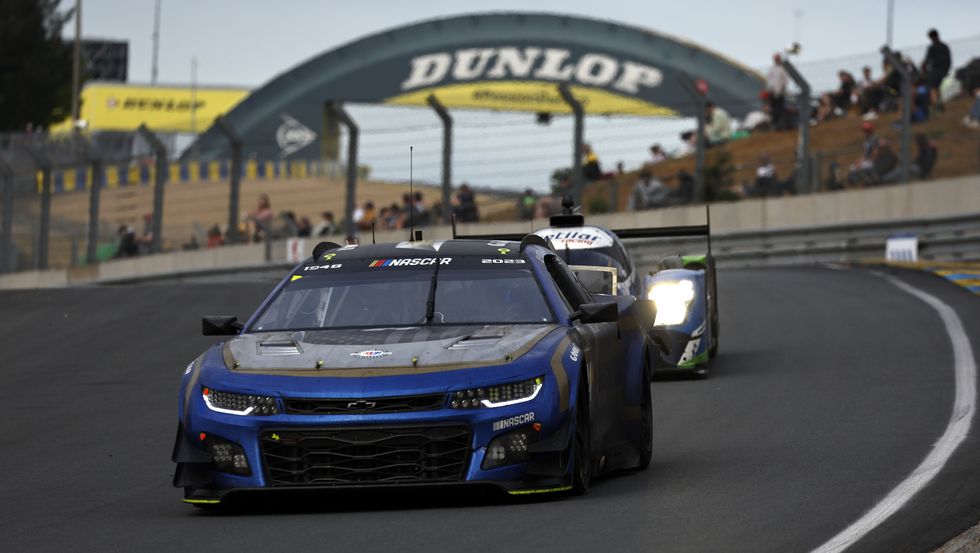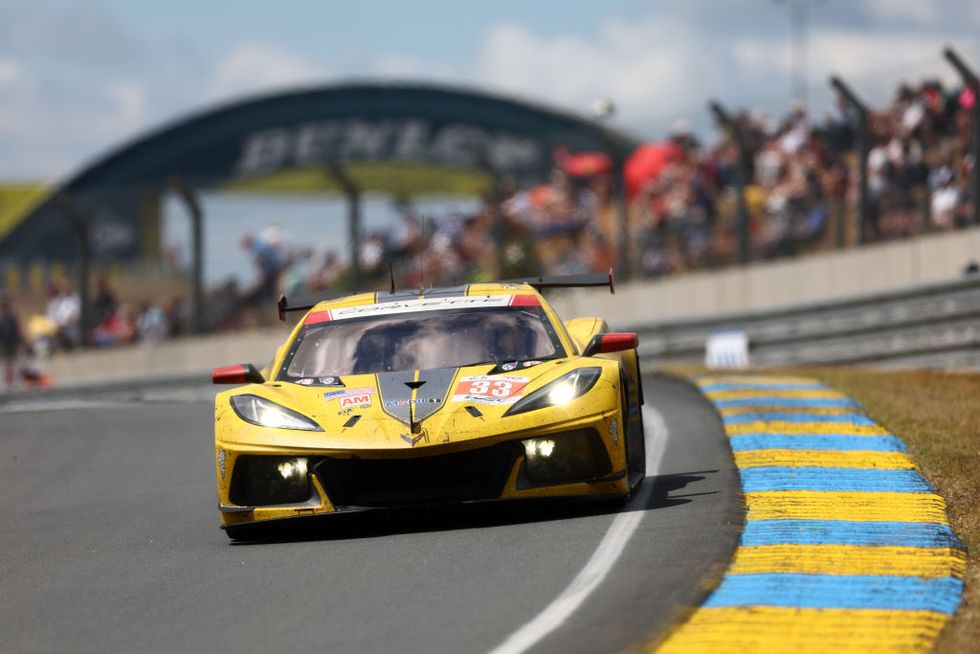With the checkered flag falling Sunday afternoon (morning in the U.S.), the 100th edition of the always grueling 24 Hours of Le Mans is now in the books.
And as its full history is written, it will be marked by several notable storylines, including:
- Ferrari’s dramatic upset of Toyota in the new Hypercar class, which features hybrid technology
- Poland’s Little Engine That Could, so to speak, won LMP2
- NASCAR and Team Hendrick’s joint venture, Garage 56
- The GTE class made its final run ever at Le Mans
Here’s a breakdown of how all four classes performed at the 8.467-mile Circuit de la Sarthe:
HYPERCAR
Ferrari could not have written a more fantastic script in its celebrated return to Le Mans following a 50-year absence.
Making its first appearance in the French classic since 1973, the No. 51 Ferrari AF Corse 499P Hypercar pulled off one of the biggest upsets in the centenary event’s history, snapping the five-year winning streak of Toyota Gazoo.
Despite the 50-year absence, Antonio Giovanazzi, James Calado and Alessandro Pier Guidi, who brought the car home to take the checkered flag, gave Ferrari its 10th overall win at Le Mans and its first triumph since 1965.
Which leaves just one question remaining: why did it take the Italian legend a half-century to decide to return to the greatest endurance race in the world? Had the prancing horse known the success that lay in store for it, perhaps it should have returned several years earlier.
As for the runner-up No. 8 Toyota piloted by Sebastien Buemi, Brendon Hartley, and anchor driver Ryo Hirakawa, it finished 1 minute, 21 seconds behind the winning team.
The Japanese manufacturer’s hopes of winning were dashed with about 1 hour, 44 minutes left in the race when Hirakawa locked up his brakes and hit the wall, leading to a three-minute pit stop to repair damage. But that was enough time to end Toyota’s hopes of earning No. 6 in a row.
Rounding out the podium was the No. 2 Cadillac Racing V-Series.R of Chip Ganassi Racing (drivers were Richard Westbrook, Alex Lynn and Earl Bamber), carrying the flag for IMSA. CGR also finished fourth with its No. 3 LMDH prototype, while Ferrari’s No. 5 rounded out the top-five.
“I couldn’t be more proud of all three Cadillacs crossing the finish line, which I think is a huge feat at this race especially considering everything that happened. This is the busiest Le Mans that I can remember for the past few years and we were able to have such a strong finish,” said GM sports car racing program manager Laura Wontrop Klauser, who also celebrated a class victory by the Chevrolet Corvette team. “We can’t wait to be back next year and go for that top step.”
Also of note, Team Penske’s much-anticipated Porsche finished sixth.
LMP2
This is a perfect example of why small teams never give up hope of pulling off a dream finish.
The No. 34 Inter Europol ORECA 07-Gibson entry of Albert Costa, Jakub Smiechowski and the injured Fabio Scherer (who still managed to drive even with a broken foot) gave Poland its first-ever win in any class of competition at Le Mans.
The winning team didn’t have it easy in the closing stages of the race, as it was forced to compete without radio communication, leaving the team to resort to manually holding up signage on pit wall whenever it needed to convey messages to whichever driver was behind the wheel at the time.
The team won by 21.015 seconds over runner-up No. 41 Team WRT (Louis Deletraz, Rui Andrade and Robert Kubica). Meanwhile, the No. 30 Duqueine squad (Renee Binder, Neel Jani and Nicolas Pino) also earned a podium finish.
Rounding out the Top 5 were No. 36 Alpine in fourth place and No. 31 Team WRT in fifth place.
INNOVATIVE CAR, GARAGE 56
Arguably the most anticipated and most watched class of all was the lone one-car entry in the “Innovative Car” class, namely that of Garage 56, the joint venture between NASCAR and Hendrick Motorsports. It was NASCAR’s first presence at Le Mans since 1976 and also helped mark the sanctioning body’s 75th anniversary of existence this year.
Anyway you sliced it, the Garage 56 entry driven by seven-time NASCAR Cup champ Jimmie Johnson, F1 great Jenson Button and Mike Rockenfeller combined to check off all boxes in the car’s debut at Le Mans.
But the biggest checkmark for the No. 24 Chevrolet Camaro ZL1, which finished 39th overall, was that it ultimately did what it set out to do, finishing all 24 hours of the event.
As they would say in neighboring Italy, “Bravissimo!”
LMGTE AM
Corvette Racing and its pole-sitting No. 33 C8.R. entry driven by Ben Keating, Nico Varrone and Nicky Catsburg, gave a great illustration of tenacity and patience, bouncing back after falling two laps down earlier in the race due to repairs to fix a failed damper.
After those repairs were finished, the team methodically clicked off passes of opposing cars, gained back the first of its two lost laps, ultimately got back on the lead lap and went on to win what will be the final GTE race in 24 Hours of Le Mans history.
Rounding out the podium was the No. 25 ORT by TF Sport Aston Martin Vantage (drivers were Ahmad Al Harthy, Michael Dinan and Charles Eastwood) and third-place finishing team, the No. 86 GR Racing Porsche 911 RSR-19 (drivers were Benjamin Barker, Riccardo Pera and Michael Wainwright).
There almost was another historical mark made in the class as the No. 85 Iron Dames Porsche – which boasted an all-female crew – would likely have earned a podium finish had it not been for a lengthy repair stint that ultimately left it with a still respectable fourth-place showing.
Lastly, the race was marred by heavy rain at times that led to a number of cars sailing off-track and into the grass.
Still, the whole event was arguably one of the most exciting episodes in 24 Hours of Le Mans history and gives fans and competitors alike something to look forward to as the second century of racing at Le Mans will begin in 2024.
Follow Autoweek contributor Jerry Bonkowski on Twitter @JerryBonkowski
Read the full article here






